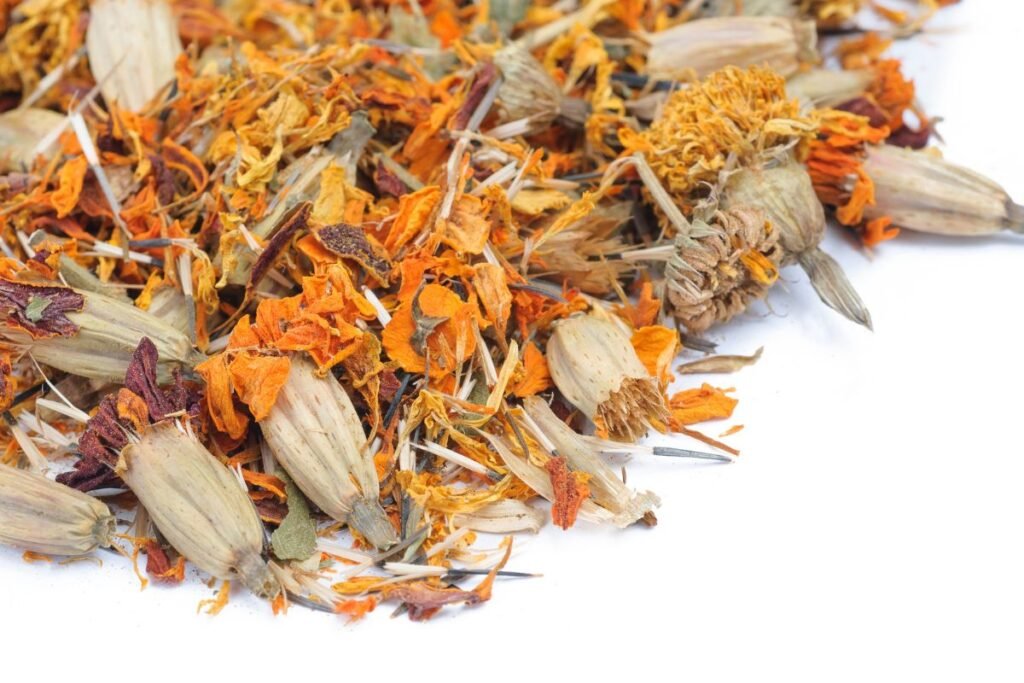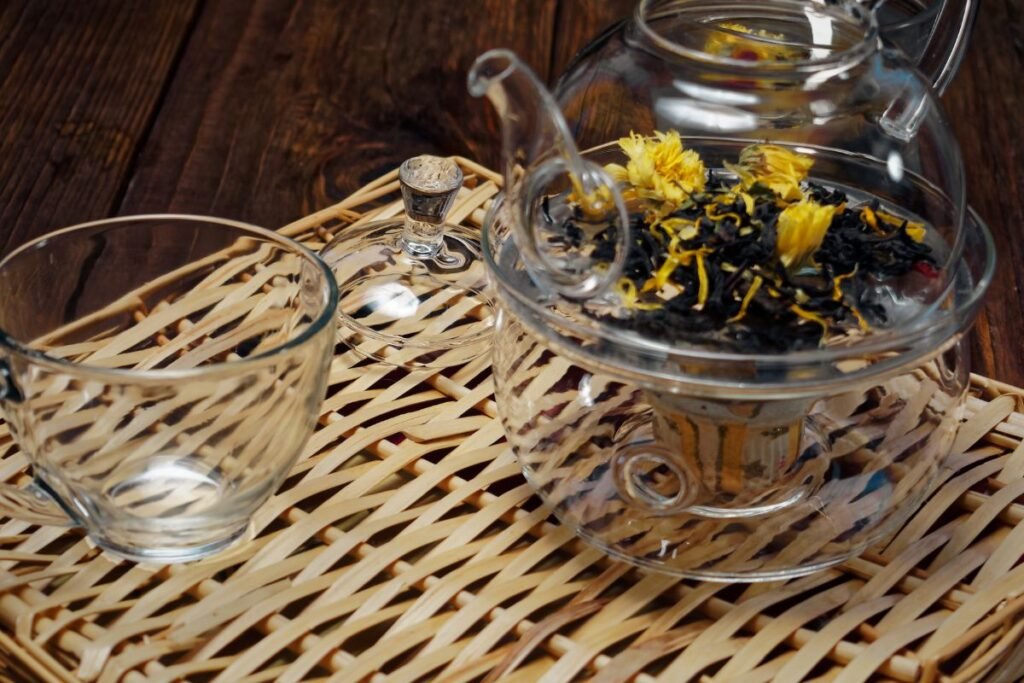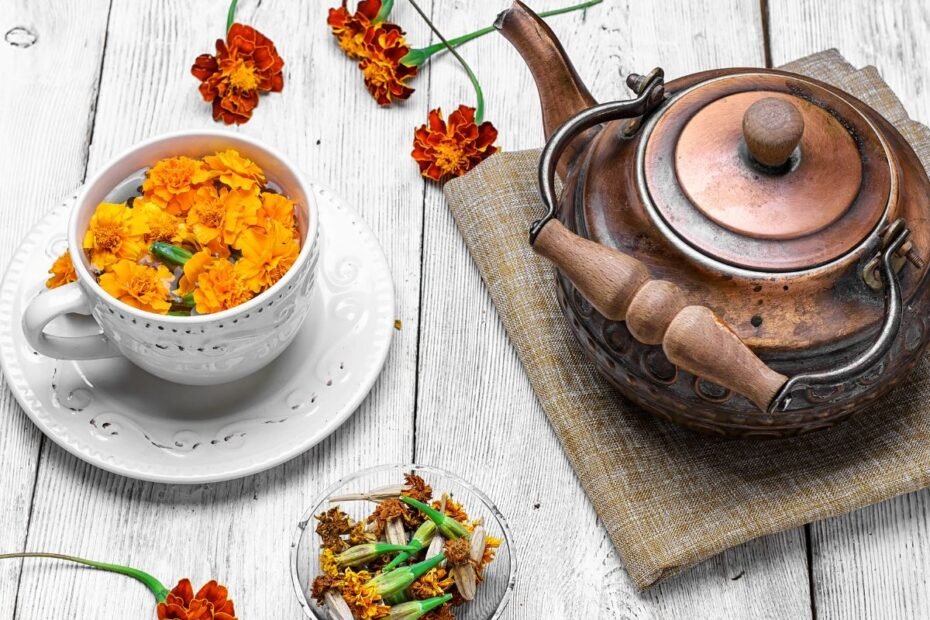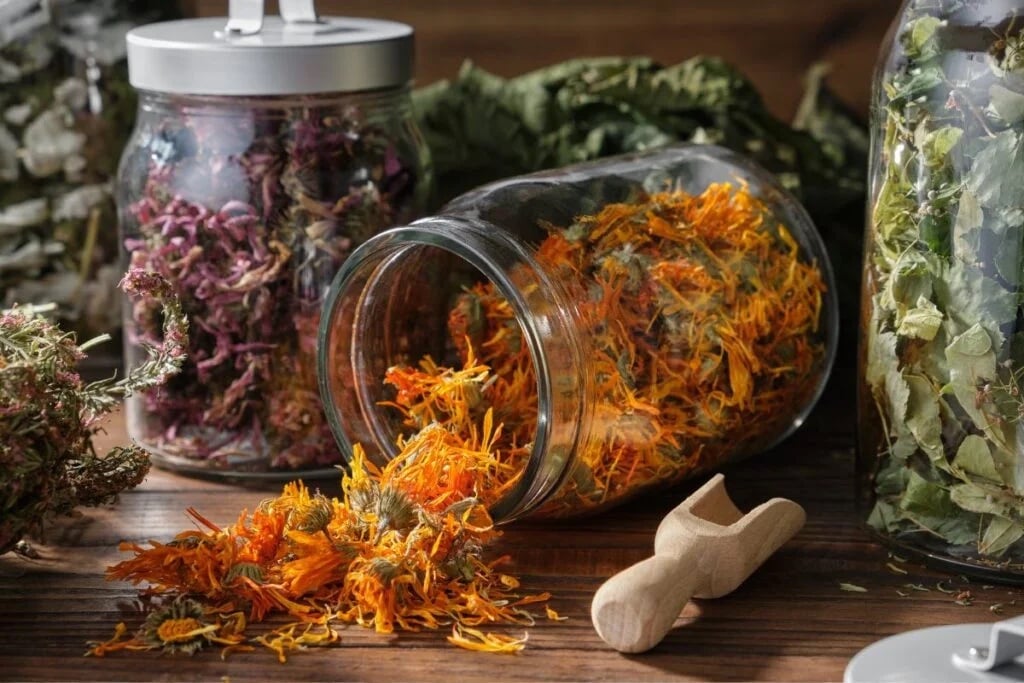Marigolds are a familiar flower in our nursery. They have another name as tagettes. The blossoms are unique with a spicy scent, you can distinguish them clearly. Marigolds are so undemanding that they grow naturally as weeds in some countries. But that is not all. Do you know marigold tea benefits for health? Perhaps some of you are even surprised to make tea from tagettes. But don’t be surprised. Not only is it brewed, but it also has beneficial medicinal properties. And if you want to find out which ones, read on.
Marigolds As Plant
Marigolds (Tagetes) belong to the genus Asteraceae. These flowers are native to temperate, subtropical, and tropical climates in North and South America.
They are grown in flowerbeds as ornamental plants in many countries. Marigolds are also planted among vegetables, due to act as natural protection from pests.
It is an annual herb with erect, richly branched flowers. Depending on the variety, they vary in height, size, number of flowers, and color. Leaves are opposite, sometimes opposite at the shoot apex, and sometimes pinnately divided 1-3 times.
The flowers are clustered in racemes, which grow singly at the apex of the shoots. Blooms in June–September with yellow, orange, brown, lemon, speckled, and pink flowers. It blooms longer when you pick the flowers continuously.
The fruit of the marigold is a long, sometimes flattened husk.
The most commonly cultivated marigolds in flowerbeds are the French marigolds (Tagetes patula) and the African marigolds (Tagetes erecta). The signet marigold (Tagetes tenuifolia), the Mexican mint marigold (Tagetes lucida), the wild marigold (Tagetes minuta), and Tagetes filifolia are also common.

Are All Marigolds Suitable for Making Tea?
As we can see, there is an enormous variety and types of marigolds. The question is: are all marigolds suitable for health? And is it possible to prepare and drink from each one?
Only the yellow and orange-colored tagetes are suitable for making tea. These are the French marigolds and the African marigolds. Other species and varieties are grown only as ornamental plants.
What Is Marigold Tea Made of?
Only the flowers of the plant are used to make marigold tea. They can be used fresh, just picked, dried, or frozen.
You can collect the flowers at any time during flowering. Pick only young, open, undeveloped, and unblemished flowers with the stalk. Dry the plucked flowers in the oven or fruit dryer, or freeze them.
Flowers for drying or freezing should only be picked in dry weather. It needs dry dew and well-developed blossom.
You can use dried and crushed marigold blossoms as a condiment for savory fish and meat dishes and flavoring soups and salads. In Georgian cuisine, marigolds are one of the most popular spices.

What Does Marigold Tea Taste Like?
As marigold tea has a pungent, peculiar, and strong smell, I am concerned about whether this tea can be tasty to drink. However, marigold tea has a rather pleasant citrus flavor with a hint of aniseed. It has a slightly peppery bitterness, but less than calendula tea.
Marigold Tea Benefits
Like most bitter herbs, marigold tea eliminates parasites from the body. It has sweat-inducing and diuretic properties. It is suitable for use during colds.
What Are The Other Health Benefits of Marigold Tea?
- It is rich in lutein ether, essential for a healthy eye. This substance absorbs up to 90% of ultraviolet rays and protects the body (especially the eyes) from them. In addition, lutein ether is better absorbed than plain lutein.
- It also contains beta-carotene, which is the basis of vitamin A. This vitamin is essential for good eyesight and for maintaining the immune system. In addition, beta-carotene is a powerful antioxidant with anti-inflammatory properties.
- Marigold tea cleanses toxins from the body and improves liver and gallbladder health.
- Protects against gastrointestinal and intestinal diseases, stomach ulcers, and gastritis.
- It also relieves toothaches and inflammation.
- The marigold poultice treats eczema and other skin diseases.
- It is irreplaceable in the treatment of joint pain. That’s why it is particularly effective for arthritis.

Marigold Tea Side Effects
Marigold tea is safe for most people if consumed in recommended amounts and moderation. However, people allergic to Asteraceae should not consume this tea. Either pregnant women or breastfeeding women should avoid tagette tea.
If you are uncertain about the use or dosage of marigold tea, consult your doctor or pharmacist.
Marigold Tea Benefits Against Parasites
Most parasites living in the body cannot tolerate bitter plants. Therefore, serenity tea is an excellent natural remedy to drive them out of the body.
Ingredients:
- 1 tbsp. of fresh marigold flowers
- 300 ml of water
Preparation: cover with boiling water, sheathe, and leave to cool. Strain.
Use: take 2 tablespoons of the infusion three times/day, before meals. Use this method for 2 weeks.

Marigold Tea for Pancreatic Diseases
Marigold tea is suitable for various pancreas, liver, and bile ailments. The folk medicine uses marigold tea for diabetes treatment and prevention.
Ingredients:
- 1 crushed marigold blossom
- 1 glass of water
Preparation:
Crush the flowers, cover them with water, and bring them to a boil. Leave it to infuse for 15-20 minutes. Drain.
Use: drink ¼ glass 4 times a day.
Tagette Tea for Arthritis
Marigold tea benefits to relief arthritis. It relieves pain and inflammation. The drink acts as a natural diuretic, helping to remove accumulated fluids.
Ingredients:
- 1 tbsp. of chopped dried marigold flowers
- 1 glass of water
Preparation: Pour a glass of boiling water over the flowers and leave to steep for 2 hours. Then strain.
Use: take 2 tbsp. of drink, 3 to 4 times a day. The duration of one course of treatment is 1.5 months. The effect lasts approximately 6 months. If necessary, repeat the treatment afterward.

Marigold Tea Benefits for Flu and Colds
This marigold tea benefits hot inhalations and is effective in relieving runny noses, unclogging the nose, easing breathing, fighting viruses and bacteria, and helping you to recover faster.
Ingredients:
- 8–10 small marigold flowers (fresh or dried)
- 1 liter of water
Preparation:
Prepare this tea immediately in a thermos. Cover the flowers with boiling water, and leave to steep for one hour.
Consumption: sip the entire amount during the day.
Marigold tea is unusual in many regions, as is its use for food. However, it is a healing, health-giving, and very beneficial tea for our health. If you don’t grow tagettes, you can buy marigold blossom tea in pharmacies or specialized shops.
Sources:
https://www.vle.lt/straipsnis/serentis/
https://frolicandfare.com/how-to-make-marigold-tea/
https://www.rxlist.com/supplements/tagetes.htm
https://www.planetayurveda.com/library/marigold-tagetes-erecta-uses-and-health-benefits/
Associative photos from © Canva.

